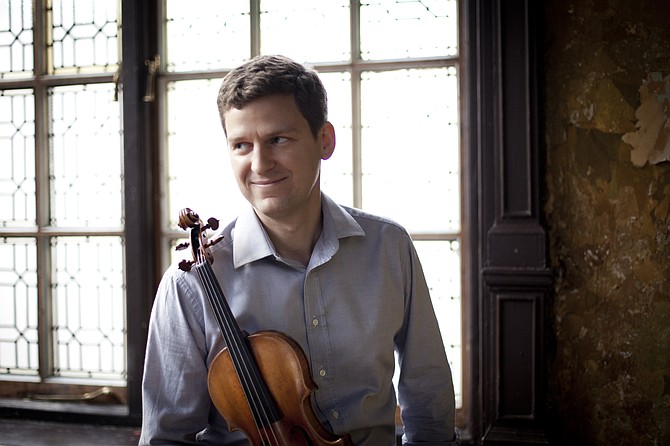 Facebook
Facebook
 X
X
 Instagram
Instagram
 TikTok
TikTok
 Youtube
Youtube

“There is no longer a single idea explaining everything, but an infinite number of essences giving a meaning to an infinite number of objects. The world comes to a stop, but also lights up.” — Albert Camus, The Myth of Sisyphus and Other Essays
That quote from Camus would be about the best review of Harmonielehre anyone could ever hope to write. If I were braver I would have left that quote as the only thing in this column about Saturday night's performance by the San Diego Symphony.
As it is, I will elaborate. Even if one has never read the famous Camus essay or the original Greek myths, we all find ourselves confronted with Sisyphus everyday.
Sisyphus was condemned, by the gods, to roll a boulder up a mountain only to have it roll down and then start the process over. He was doomed to an eternal, meaningless repetition of labor.
How many millions are heading to work on Monday to face the same boulder and roll it up the corporate mountain again? It’s a familiar story.
Yet there is something in the meaningless repetition of a task which takes on the significance of the quote above. The single idea is Sisyphus’s stone and it explains his eternal existence yet through the repetition “an infinite number of essences give meaning to an infinite number of objects.” There isn’t one stone and one mountain but infinite stones and mountains contained in the repetition of the same.
John Adams gives us the infinite essence of music in the repetition of the material, especially in the concluding section of the music. The world came to a stop and the music lit it up.
Edo de Waart and the San Diego Symphony crushed this boulder and, indeed, the entire mountain into a pile of rubble. De Waart ruled the complexities of the score with a steady hand. He conducted the premiere of the piece 30 years ago in San Francisco and that long-term relationship expressed itself in the relatively short relationship between the conductor and the San Diego Symphony.
Violinist James Ehnes played the Beethoven Violin Concerto and it was as creamy as could be.
Having Harmonielehre start the concert and Beethoven’s Violin Concerto conclude the concert emphasized the almost sentimental tone of Beethoven’s music. I was also struck by the constant repetition of the first movement theme. It was just a repetitious as Harmonielehre but the repetition was expressed in melody more than rhythm and harmony as in John Adams’s music.
Speaking of the first movement, I could have listened to the cadenza all day long. Ehnes, as a performer, was quiet in his body and facial expression. There were none of the pained grimaces of constipation which some, not all--but some, solo violinists employ.
Ehnes’s playing was mesmerizing in and of itself. We didn’t need to see him “feeling it.” The tone and quality of his playing took care of it all.


“There is no longer a single idea explaining everything, but an infinite number of essences giving a meaning to an infinite number of objects. The world comes to a stop, but also lights up.” — Albert Camus, The Myth of Sisyphus and Other Essays
That quote from Camus would be about the best review of Harmonielehre anyone could ever hope to write. If I were braver I would have left that quote as the only thing in this column about Saturday night's performance by the San Diego Symphony.
As it is, I will elaborate. Even if one has never read the famous Camus essay or the original Greek myths, we all find ourselves confronted with Sisyphus everyday.
Sisyphus was condemned, by the gods, to roll a boulder up a mountain only to have it roll down and then start the process over. He was doomed to an eternal, meaningless repetition of labor.
How many millions are heading to work on Monday to face the same boulder and roll it up the corporate mountain again? It’s a familiar story.
Yet there is something in the meaningless repetition of a task which takes on the significance of the quote above. The single idea is Sisyphus’s stone and it explains his eternal existence yet through the repetition “an infinite number of essences give meaning to an infinite number of objects.” There isn’t one stone and one mountain but infinite stones and mountains contained in the repetition of the same.
John Adams gives us the infinite essence of music in the repetition of the material, especially in the concluding section of the music. The world came to a stop and the music lit it up.
Edo de Waart and the San Diego Symphony crushed this boulder and, indeed, the entire mountain into a pile of rubble. De Waart ruled the complexities of the score with a steady hand. He conducted the premiere of the piece 30 years ago in San Francisco and that long-term relationship expressed itself in the relatively short relationship between the conductor and the San Diego Symphony.
Violinist James Ehnes played the Beethoven Violin Concerto and it was as creamy as could be.
Having Harmonielehre start the concert and Beethoven’s Violin Concerto conclude the concert emphasized the almost sentimental tone of Beethoven’s music. I was also struck by the constant repetition of the first movement theme. It was just a repetitious as Harmonielehre but the repetition was expressed in melody more than rhythm and harmony as in John Adams’s music.
Speaking of the first movement, I could have listened to the cadenza all day long. Ehnes, as a performer, was quiet in his body and facial expression. There were none of the pained grimaces of constipation which some, not all--but some, solo violinists employ.
Ehnes’s playing was mesmerizing in and of itself. We didn’t need to see him “feeling it.” The tone and quality of his playing took care of it all.
Comments